Managing Information and Technology: Tesco Business Analysis Report
VerifiedAdded on 2023/04/19
|12
|3924
|453
Report
AI Summary
This report provides a comprehensive analysis of Tesco, a multinational retail giant. It begins with an introduction to Tesco and its business, followed by an examination of the various strategies it employs, including growth in core and international markets, brand value enhancement, CSR initiatives, innovation, training, and low pricing. The report then details Tesco's diverse range of products and services, from groceries and electronics to financial and telecommunication services. A critical analysis of the competitive business environment, employing Porter's Five Forces, highlights the bargaining power of customers and suppliers, the intensity of competition, the threat of substitute products, and the threat of new entrants. The report also delves into Tesco's primary and secondary activities, specifically inbound logistics, operations, marketing and sales, and service, along with support activities such as procurement, technology development, human resource management, and infrastructure. The report concludes with an analysis of Tesco's strengths and weaknesses, and provides suggestions for the deployment of information technology to improve business processes and enhance competitive positioning.
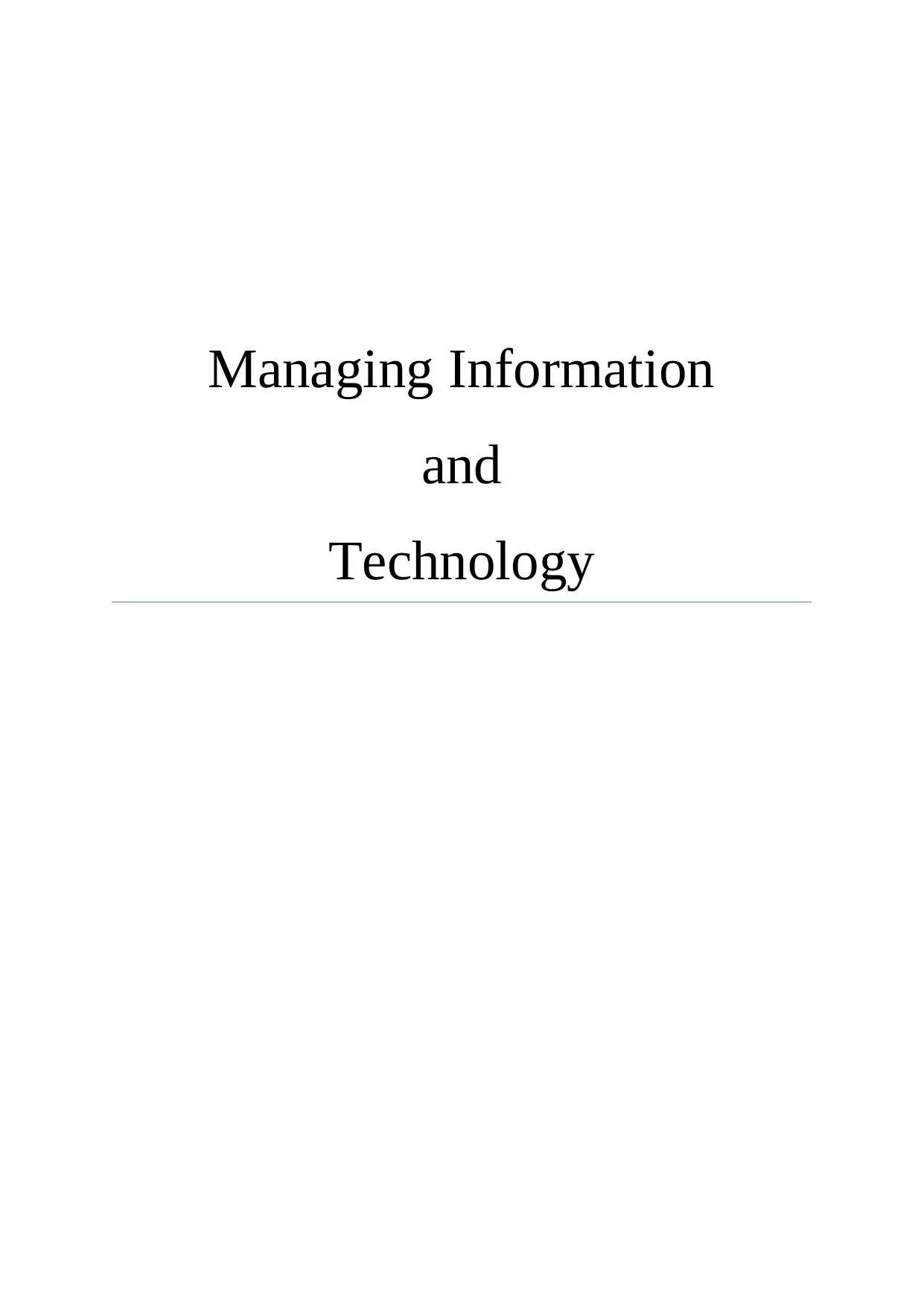
Managing Information
and
Technology
and
Technology
Paraphrase This Document
Need a fresh take? Get an instant paraphrase of this document with our AI Paraphraser
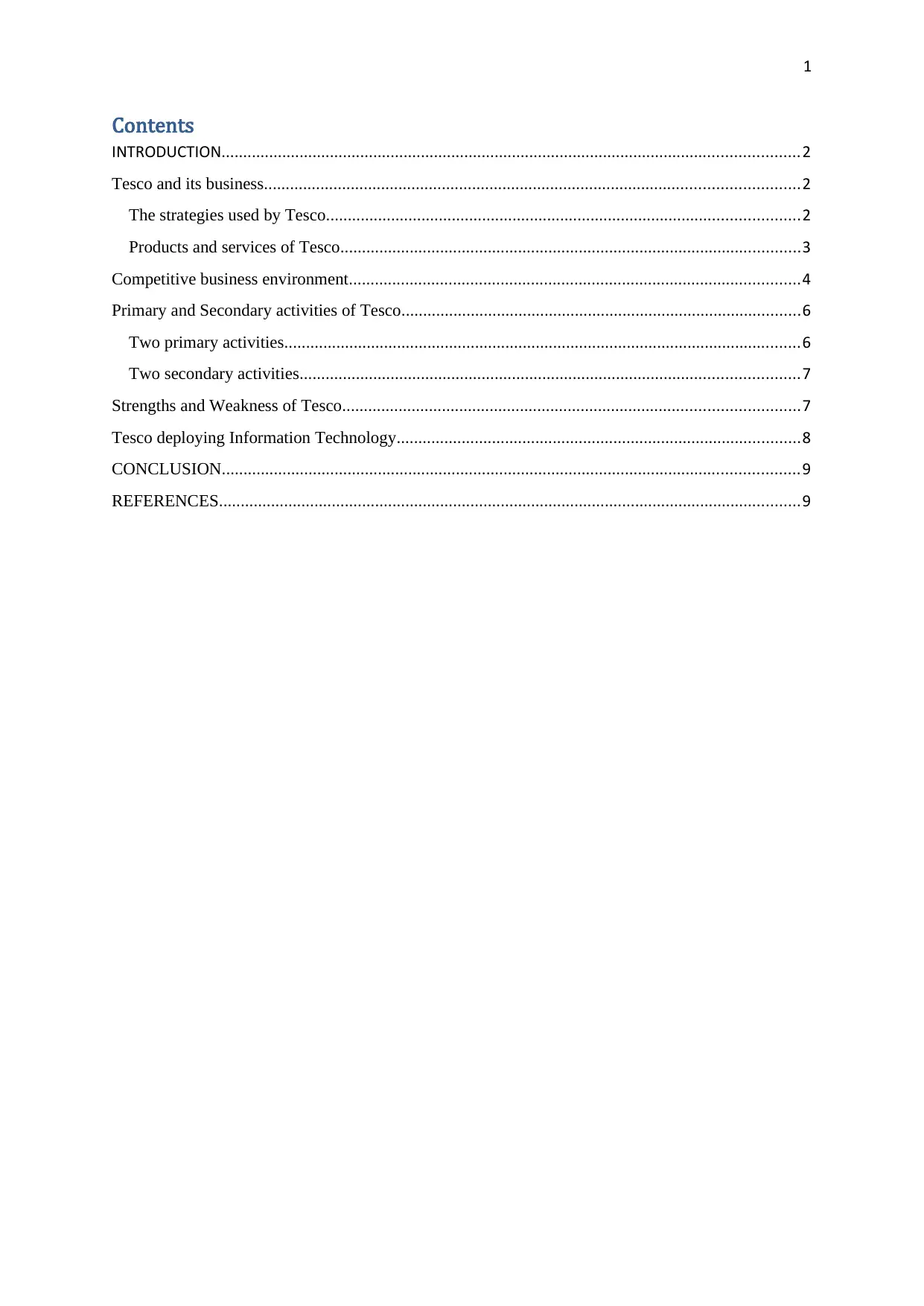
1
Contents
INTRODUCTION.....................................................................................................................................2
Tesco and its business...........................................................................................................................2
The strategies used by Tesco.............................................................................................................2
Products and services of Tesco..........................................................................................................3
Competitive business environment........................................................................................................4
Primary and Secondary activities of Tesco............................................................................................6
Two primary activities.......................................................................................................................6
Two secondary activities...................................................................................................................7
Strengths and Weakness of Tesco.........................................................................................................7
Tesco deploying Information Technology.............................................................................................8
CONCLUSION.....................................................................................................................................9
REFERENCES......................................................................................................................................9
Contents
INTRODUCTION.....................................................................................................................................2
Tesco and its business...........................................................................................................................2
The strategies used by Tesco.............................................................................................................2
Products and services of Tesco..........................................................................................................3
Competitive business environment........................................................................................................4
Primary and Secondary activities of Tesco............................................................................................6
Two primary activities.......................................................................................................................6
Two secondary activities...................................................................................................................7
Strengths and Weakness of Tesco.........................................................................................................7
Tesco deploying Information Technology.............................................................................................8
CONCLUSION.....................................................................................................................................9
REFERENCES......................................................................................................................................9
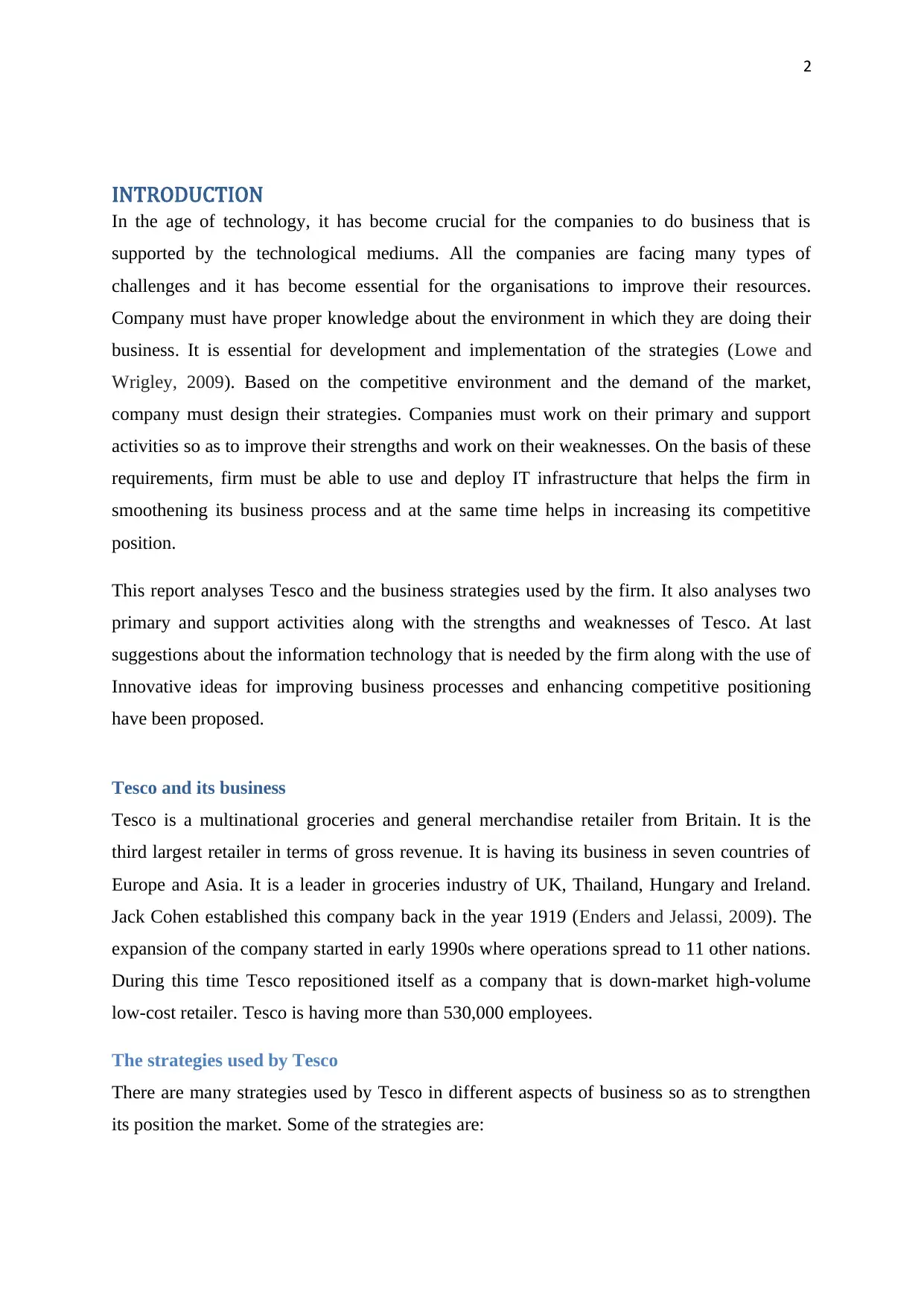
2
INTRODUCTION
In the age of technology, it has become crucial for the companies to do business that is
supported by the technological mediums. All the companies are facing many types of
challenges and it has become essential for the organisations to improve their resources.
Company must have proper knowledge about the environment in which they are doing their
business. It is essential for development and implementation of the strategies (Lowe and
Wrigley, 2009). Based on the competitive environment and the demand of the market,
company must design their strategies. Companies must work on their primary and support
activities so as to improve their strengths and work on their weaknesses. On the basis of these
requirements, firm must be able to use and deploy IT infrastructure that helps the firm in
smoothening its business process and at the same time helps in increasing its competitive
position.
This report analyses Tesco and the business strategies used by the firm. It also analyses two
primary and support activities along with the strengths and weaknesses of Tesco. At last
suggestions about the information technology that is needed by the firm along with the use of
Innovative ideas for improving business processes and enhancing competitive positioning
have been proposed.
Tesco and its business
Tesco is a multinational groceries and general merchandise retailer from Britain. It is the
third largest retailer in terms of gross revenue. It is having its business in seven countries of
Europe and Asia. It is a leader in groceries industry of UK, Thailand, Hungary and Ireland.
Jack Cohen established this company back in the year 1919 (Enders and Jelassi, 2009). The
expansion of the company started in early 1990s where operations spread to 11 other nations.
During this time Tesco repositioned itself as a company that is down-market high-volume
low-cost retailer. Tesco is having more than 530,000 employees.
The strategies used by Tesco
There are many strategies used by Tesco in different aspects of business so as to strengthen
its position the market. Some of the strategies are:
INTRODUCTION
In the age of technology, it has become crucial for the companies to do business that is
supported by the technological mediums. All the companies are facing many types of
challenges and it has become essential for the organisations to improve their resources.
Company must have proper knowledge about the environment in which they are doing their
business. It is essential for development and implementation of the strategies (Lowe and
Wrigley, 2009). Based on the competitive environment and the demand of the market,
company must design their strategies. Companies must work on their primary and support
activities so as to improve their strengths and work on their weaknesses. On the basis of these
requirements, firm must be able to use and deploy IT infrastructure that helps the firm in
smoothening its business process and at the same time helps in increasing its competitive
position.
This report analyses Tesco and the business strategies used by the firm. It also analyses two
primary and support activities along with the strengths and weaknesses of Tesco. At last
suggestions about the information technology that is needed by the firm along with the use of
Innovative ideas for improving business processes and enhancing competitive positioning
have been proposed.
Tesco and its business
Tesco is a multinational groceries and general merchandise retailer from Britain. It is the
third largest retailer in terms of gross revenue. It is having its business in seven countries of
Europe and Asia. It is a leader in groceries industry of UK, Thailand, Hungary and Ireland.
Jack Cohen established this company back in the year 1919 (Enders and Jelassi, 2009). The
expansion of the company started in early 1990s where operations spread to 11 other nations.
During this time Tesco repositioned itself as a company that is down-market high-volume
low-cost retailer. Tesco is having more than 530,000 employees.
The strategies used by Tesco
There are many strategies used by Tesco in different aspects of business so as to strengthen
its position the market. Some of the strategies are:
⊘ This is a preview!⊘
Do you want full access?
Subscribe today to unlock all pages.

Trusted by 1+ million students worldwide
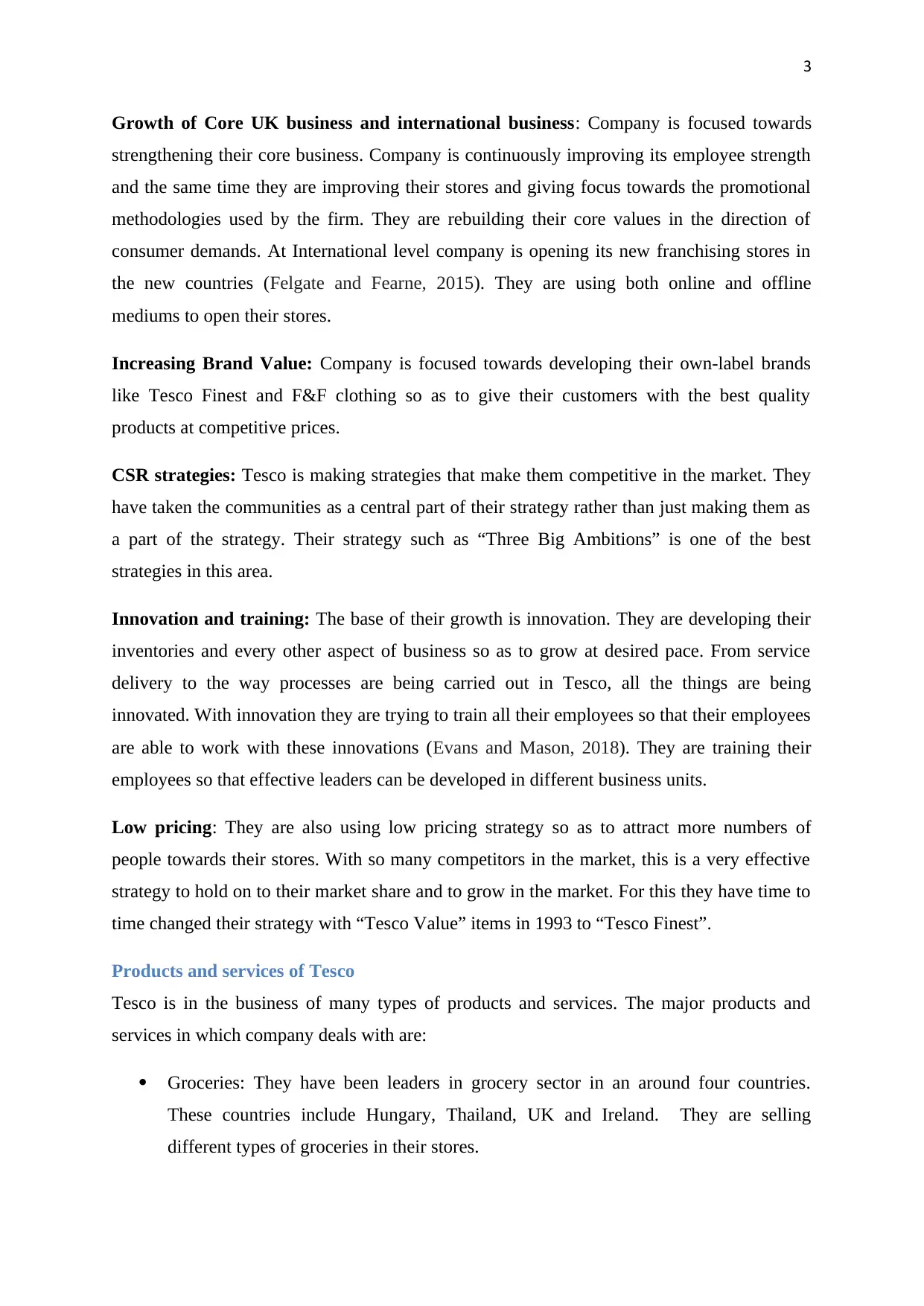
3
Growth of Core UK business and international business: Company is focused towards
strengthening their core business. Company is continuously improving its employee strength
and the same time they are improving their stores and giving focus towards the promotional
methodologies used by the firm. They are rebuilding their core values in the direction of
consumer demands. At International level company is opening its new franchising stores in
the new countries (Felgate and Fearne, 2015). They are using both online and offline
mediums to open their stores.
Increasing Brand Value: Company is focused towards developing their own-label brands
like Tesco Finest and F&F clothing so as to give their customers with the best quality
products at competitive prices.
CSR strategies: Tesco is making strategies that make them competitive in the market. They
have taken the communities as a central part of their strategy rather than just making them as
a part of the strategy. Their strategy such as “Three Big Ambitions” is one of the best
strategies in this area.
Innovation and training: The base of their growth is innovation. They are developing their
inventories and every other aspect of business so as to grow at desired pace. From service
delivery to the way processes are being carried out in Tesco, all the things are being
innovated. With innovation they are trying to train all their employees so that their employees
are able to work with these innovations (Evans and Mason, 2018). They are training their
employees so that effective leaders can be developed in different business units.
Low pricing: They are also using low pricing strategy so as to attract more numbers of
people towards their stores. With so many competitors in the market, this is a very effective
strategy to hold on to their market share and to grow in the market. For this they have time to
time changed their strategy with “Tesco Value” items in 1993 to “Tesco Finest”.
Products and services of Tesco
Tesco is in the business of many types of products and services. The major products and
services in which company deals with are:
Groceries: They have been leaders in grocery sector in an around four countries.
These countries include Hungary, Thailand, UK and Ireland. They are selling
different types of groceries in their stores.
Growth of Core UK business and international business: Company is focused towards
strengthening their core business. Company is continuously improving its employee strength
and the same time they are improving their stores and giving focus towards the promotional
methodologies used by the firm. They are rebuilding their core values in the direction of
consumer demands. At International level company is opening its new franchising stores in
the new countries (Felgate and Fearne, 2015). They are using both online and offline
mediums to open their stores.
Increasing Brand Value: Company is focused towards developing their own-label brands
like Tesco Finest and F&F clothing so as to give their customers with the best quality
products at competitive prices.
CSR strategies: Tesco is making strategies that make them competitive in the market. They
have taken the communities as a central part of their strategy rather than just making them as
a part of the strategy. Their strategy such as “Three Big Ambitions” is one of the best
strategies in this area.
Innovation and training: The base of their growth is innovation. They are developing their
inventories and every other aspect of business so as to grow at desired pace. From service
delivery to the way processes are being carried out in Tesco, all the things are being
innovated. With innovation they are trying to train all their employees so that their employees
are able to work with these innovations (Evans and Mason, 2018). They are training their
employees so that effective leaders can be developed in different business units.
Low pricing: They are also using low pricing strategy so as to attract more numbers of
people towards their stores. With so many competitors in the market, this is a very effective
strategy to hold on to their market share and to grow in the market. For this they have time to
time changed their strategy with “Tesco Value” items in 1993 to “Tesco Finest”.
Products and services of Tesco
Tesco is in the business of many types of products and services. The major products and
services in which company deals with are:
Groceries: They have been leaders in grocery sector in an around four countries.
These countries include Hungary, Thailand, UK and Ireland. They are selling
different types of groceries in their stores.
Paraphrase This Document
Need a fresh take? Get an instant paraphrase of this document with our AI Paraphraser
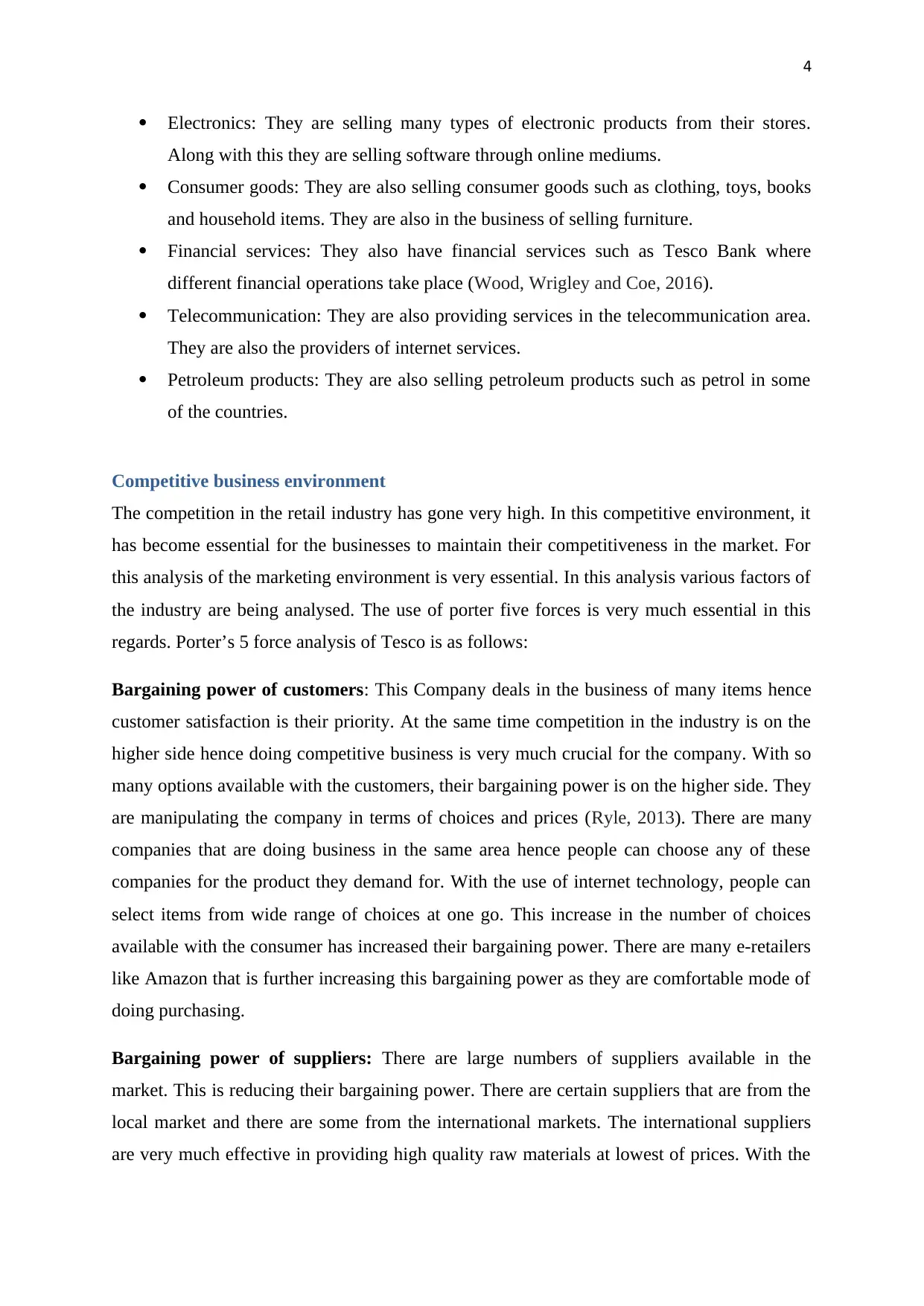
4
Electronics: They are selling many types of electronic products from their stores.
Along with this they are selling software through online mediums.
Consumer goods: They are also selling consumer goods such as clothing, toys, books
and household items. They are also in the business of selling furniture.
Financial services: They also have financial services such as Tesco Bank where
different financial operations take place (Wood, Wrigley and Coe, 2016).
Telecommunication: They are also providing services in the telecommunication area.
They are also the providers of internet services.
Petroleum products: They are also selling petroleum products such as petrol in some
of the countries.
Competitive business environment
The competition in the retail industry has gone very high. In this competitive environment, it
has become essential for the businesses to maintain their competitiveness in the market. For
this analysis of the marketing environment is very essential. In this analysis various factors of
the industry are being analysed. The use of porter five forces is very much essential in this
regards. Porter’s 5 force analysis of Tesco is as follows:
Bargaining power of customers: This Company deals in the business of many items hence
customer satisfaction is their priority. At the same time competition in the industry is on the
higher side hence doing competitive business is very much crucial for the company. With so
many options available with the customers, their bargaining power is on the higher side. They
are manipulating the company in terms of choices and prices (Ryle, 2013). There are many
companies that are doing business in the same area hence people can choose any of these
companies for the product they demand for. With the use of internet technology, people can
select items from wide range of choices at one go. This increase in the number of choices
available with the consumer has increased their bargaining power. There are many e-retailers
like Amazon that is further increasing this bargaining power as they are comfortable mode of
doing purchasing.
Bargaining power of suppliers: There are large numbers of suppliers available in the
market. This is reducing their bargaining power. There are certain suppliers that are from the
local market and there are some from the international markets. The international suppliers
are very much effective in providing high quality raw materials at lowest of prices. With the
Electronics: They are selling many types of electronic products from their stores.
Along with this they are selling software through online mediums.
Consumer goods: They are also selling consumer goods such as clothing, toys, books
and household items. They are also in the business of selling furniture.
Financial services: They also have financial services such as Tesco Bank where
different financial operations take place (Wood, Wrigley and Coe, 2016).
Telecommunication: They are also providing services in the telecommunication area.
They are also the providers of internet services.
Petroleum products: They are also selling petroleum products such as petrol in some
of the countries.
Competitive business environment
The competition in the retail industry has gone very high. In this competitive environment, it
has become essential for the businesses to maintain their competitiveness in the market. For
this analysis of the marketing environment is very essential. In this analysis various factors of
the industry are being analysed. The use of porter five forces is very much essential in this
regards. Porter’s 5 force analysis of Tesco is as follows:
Bargaining power of customers: This Company deals in the business of many items hence
customer satisfaction is their priority. At the same time competition in the industry is on the
higher side hence doing competitive business is very much crucial for the company. With so
many options available with the customers, their bargaining power is on the higher side. They
are manipulating the company in terms of choices and prices (Ryle, 2013). There are many
companies that are doing business in the same area hence people can choose any of these
companies for the product they demand for. With the use of internet technology, people can
select items from wide range of choices at one go. This increase in the number of choices
available with the consumer has increased their bargaining power. There are many e-retailers
like Amazon that is further increasing this bargaining power as they are comfortable mode of
doing purchasing.
Bargaining power of suppliers: There are large numbers of suppliers available in the
market. This is reducing their bargaining power. There are certain suppliers that are from the
local market and there are some from the international markets. The international suppliers
are very much effective in providing high quality raw materials at lowest of prices. With the
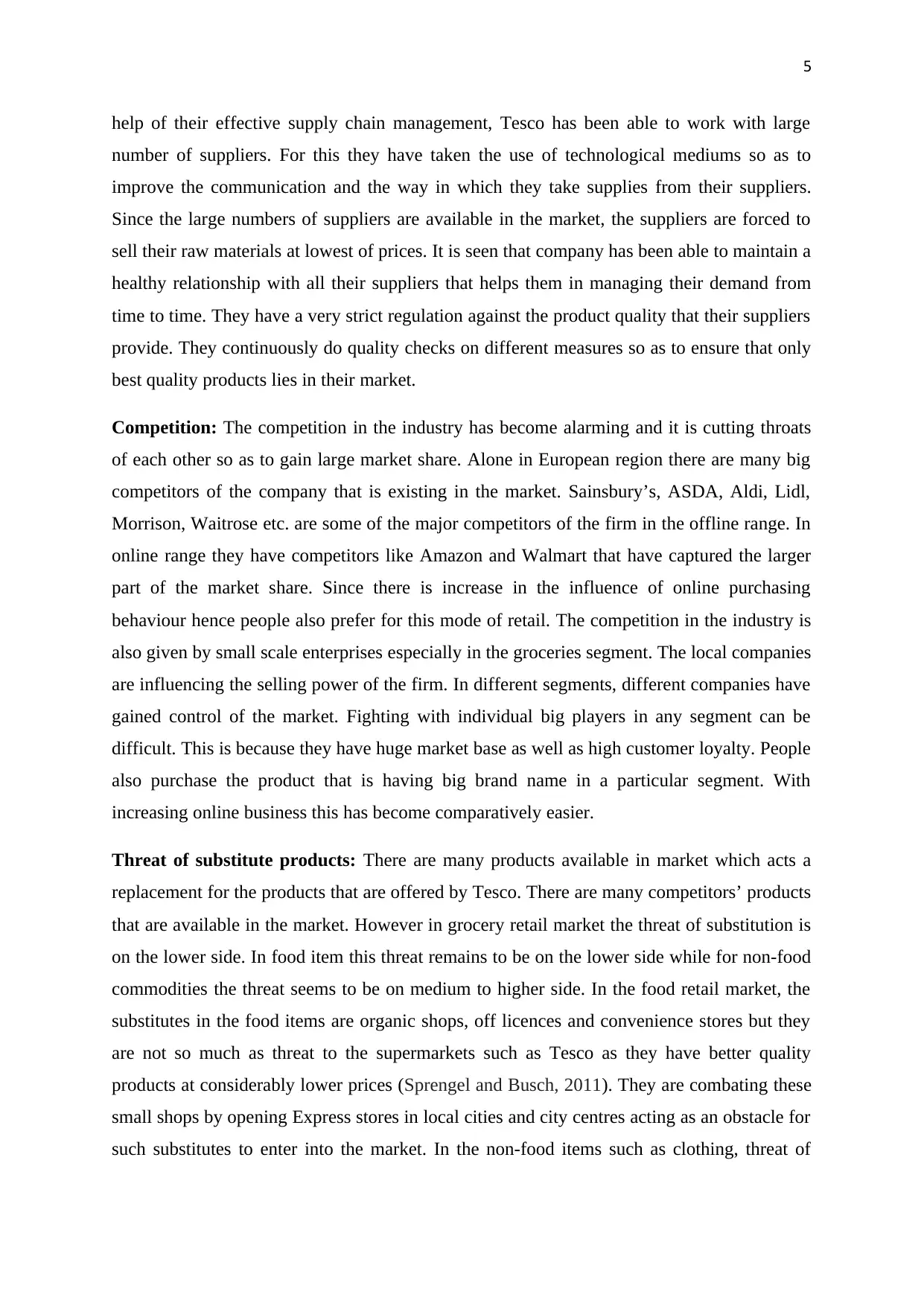
5
help of their effective supply chain management, Tesco has been able to work with large
number of suppliers. For this they have taken the use of technological mediums so as to
improve the communication and the way in which they take supplies from their suppliers.
Since the large numbers of suppliers are available in the market, the suppliers are forced to
sell their raw materials at lowest of prices. It is seen that company has been able to maintain a
healthy relationship with all their suppliers that helps them in managing their demand from
time to time. They have a very strict regulation against the product quality that their suppliers
provide. They continuously do quality checks on different measures so as to ensure that only
best quality products lies in their market.
Competition: The competition in the industry has become alarming and it is cutting throats
of each other so as to gain large market share. Alone in European region there are many big
competitors of the company that is existing in the market. Sainsbury’s, ASDA, Aldi, Lidl,
Morrison, Waitrose etc. are some of the major competitors of the firm in the offline range. In
online range they have competitors like Amazon and Walmart that have captured the larger
part of the market share. Since there is increase in the influence of online purchasing
behaviour hence people also prefer for this mode of retail. The competition in the industry is
also given by small scale enterprises especially in the groceries segment. The local companies
are influencing the selling power of the firm. In different segments, different companies have
gained control of the market. Fighting with individual big players in any segment can be
difficult. This is because they have huge market base as well as high customer loyalty. People
also purchase the product that is having big brand name in a particular segment. With
increasing online business this has become comparatively easier.
Threat of substitute products: There are many products available in market which acts a
replacement for the products that are offered by Tesco. There are many competitors’ products
that are available in the market. However in grocery retail market the threat of substitution is
on the lower side. In food item this threat remains to be on the lower side while for non-food
commodities the threat seems to be on medium to higher side. In the food retail market, the
substitutes in the food items are organic shops, off licences and convenience stores but they
are not so much as threat to the supermarkets such as Tesco as they have better quality
products at considerably lower prices (Sprengel and Busch, 2011). They are combating these
small shops by opening Express stores in local cities and city centres acting as an obstacle for
such substitutes to enter into the market. In the non-food items such as clothing, threat of
help of their effective supply chain management, Tesco has been able to work with large
number of suppliers. For this they have taken the use of technological mediums so as to
improve the communication and the way in which they take supplies from their suppliers.
Since the large numbers of suppliers are available in the market, the suppliers are forced to
sell their raw materials at lowest of prices. It is seen that company has been able to maintain a
healthy relationship with all their suppliers that helps them in managing their demand from
time to time. They have a very strict regulation against the product quality that their suppliers
provide. They continuously do quality checks on different measures so as to ensure that only
best quality products lies in their market.
Competition: The competition in the industry has become alarming and it is cutting throats
of each other so as to gain large market share. Alone in European region there are many big
competitors of the company that is existing in the market. Sainsbury’s, ASDA, Aldi, Lidl,
Morrison, Waitrose etc. are some of the major competitors of the firm in the offline range. In
online range they have competitors like Amazon and Walmart that have captured the larger
part of the market share. Since there is increase in the influence of online purchasing
behaviour hence people also prefer for this mode of retail. The competition in the industry is
also given by small scale enterprises especially in the groceries segment. The local companies
are influencing the selling power of the firm. In different segments, different companies have
gained control of the market. Fighting with individual big players in any segment can be
difficult. This is because they have huge market base as well as high customer loyalty. People
also purchase the product that is having big brand name in a particular segment. With
increasing online business this has become comparatively easier.
Threat of substitute products: There are many products available in market which acts a
replacement for the products that are offered by Tesco. There are many competitors’ products
that are available in the market. However in grocery retail market the threat of substitution is
on the lower side. In food item this threat remains to be on the lower side while for non-food
commodities the threat seems to be on medium to higher side. In the food retail market, the
substitutes in the food items are organic shops, off licences and convenience stores but they
are not so much as threat to the supermarkets such as Tesco as they have better quality
products at considerably lower prices (Sprengel and Busch, 2011). They are combating these
small shops by opening Express stores in local cities and city centres acting as an obstacle for
such substitutes to enter into the market. In the non-food items such as clothing, threat of
⊘ This is a preview!⊘
Do you want full access?
Subscribe today to unlock all pages.

Trusted by 1+ million students worldwide
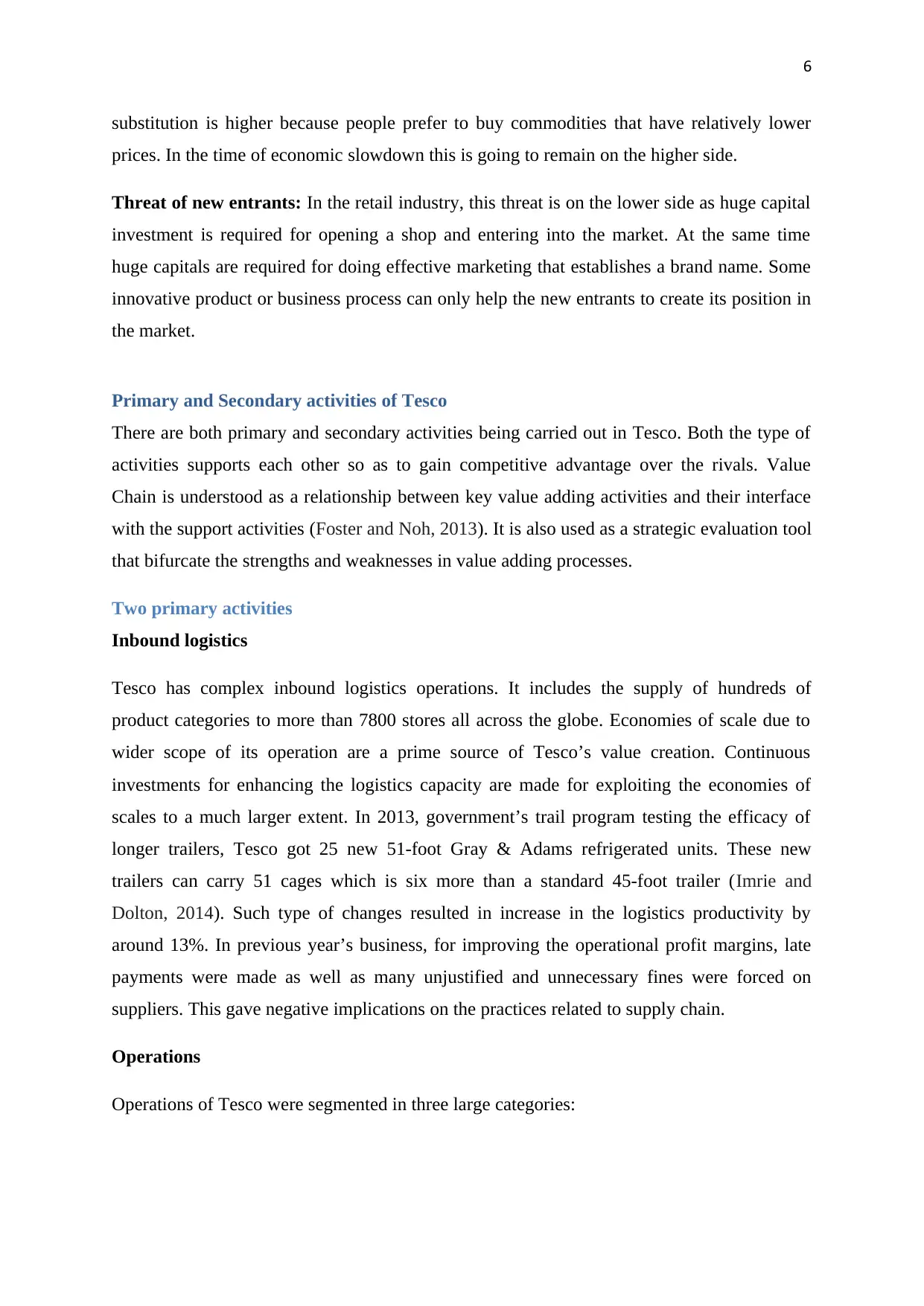
6
substitution is higher because people prefer to buy commodities that have relatively lower
prices. In the time of economic slowdown this is going to remain on the higher side.
Threat of new entrants: In the retail industry, this threat is on the lower side as huge capital
investment is required for opening a shop and entering into the market. At the same time
huge capitals are required for doing effective marketing that establishes a brand name. Some
innovative product or business process can only help the new entrants to create its position in
the market.
Primary and Secondary activities of Tesco
There are both primary and secondary activities being carried out in Tesco. Both the type of
activities supports each other so as to gain competitive advantage over the rivals. Value
Chain is understood as a relationship between key value adding activities and their interface
with the support activities (Foster and Noh, 2013). It is also used as a strategic evaluation tool
that bifurcate the strengths and weaknesses in value adding processes.
Two primary activities
Inbound logistics
Tesco has complex inbound logistics operations. It includes the supply of hundreds of
product categories to more than 7800 stores all across the globe. Economies of scale due to
wider scope of its operation are a prime source of Tesco’s value creation. Continuous
investments for enhancing the logistics capacity are made for exploiting the economies of
scales to a much larger extent. In 2013, government’s trail program testing the efficacy of
longer trailers, Tesco got 25 new 51-foot Gray & Adams refrigerated units. These new
trailers can carry 51 cages which is six more than a standard 45-foot trailer (Imrie and
Dolton, 2014). Such type of changes resulted in increase in the logistics productivity by
around 13%. In previous year’s business, for improving the operational profit margins, late
payments were made as well as many unjustified and unnecessary fines were forced on
suppliers. This gave negative implications on the practices related to supply chain.
Operations
Operations of Tesco were segmented in three large categories:
substitution is higher because people prefer to buy commodities that have relatively lower
prices. In the time of economic slowdown this is going to remain on the higher side.
Threat of new entrants: In the retail industry, this threat is on the lower side as huge capital
investment is required for opening a shop and entering into the market. At the same time
huge capitals are required for doing effective marketing that establishes a brand name. Some
innovative product or business process can only help the new entrants to create its position in
the market.
Primary and Secondary activities of Tesco
There are both primary and secondary activities being carried out in Tesco. Both the type of
activities supports each other so as to gain competitive advantage over the rivals. Value
Chain is understood as a relationship between key value adding activities and their interface
with the support activities (Foster and Noh, 2013). It is also used as a strategic evaluation tool
that bifurcate the strengths and weaknesses in value adding processes.
Two primary activities
Inbound logistics
Tesco has complex inbound logistics operations. It includes the supply of hundreds of
product categories to more than 7800 stores all across the globe. Economies of scale due to
wider scope of its operation are a prime source of Tesco’s value creation. Continuous
investments for enhancing the logistics capacity are made for exploiting the economies of
scales to a much larger extent. In 2013, government’s trail program testing the efficacy of
longer trailers, Tesco got 25 new 51-foot Gray & Adams refrigerated units. These new
trailers can carry 51 cages which is six more than a standard 45-foot trailer (Imrie and
Dolton, 2014). Such type of changes resulted in increase in the logistics productivity by
around 13%. In previous year’s business, for improving the operational profit margins, late
payments were made as well as many unjustified and unnecessary fines were forced on
suppliers. This gave negative implications on the practices related to supply chain.
Operations
Operations of Tesco were segmented in three large categories:
Paraphrase This Document
Need a fresh take? Get an instant paraphrase of this document with our AI Paraphraser
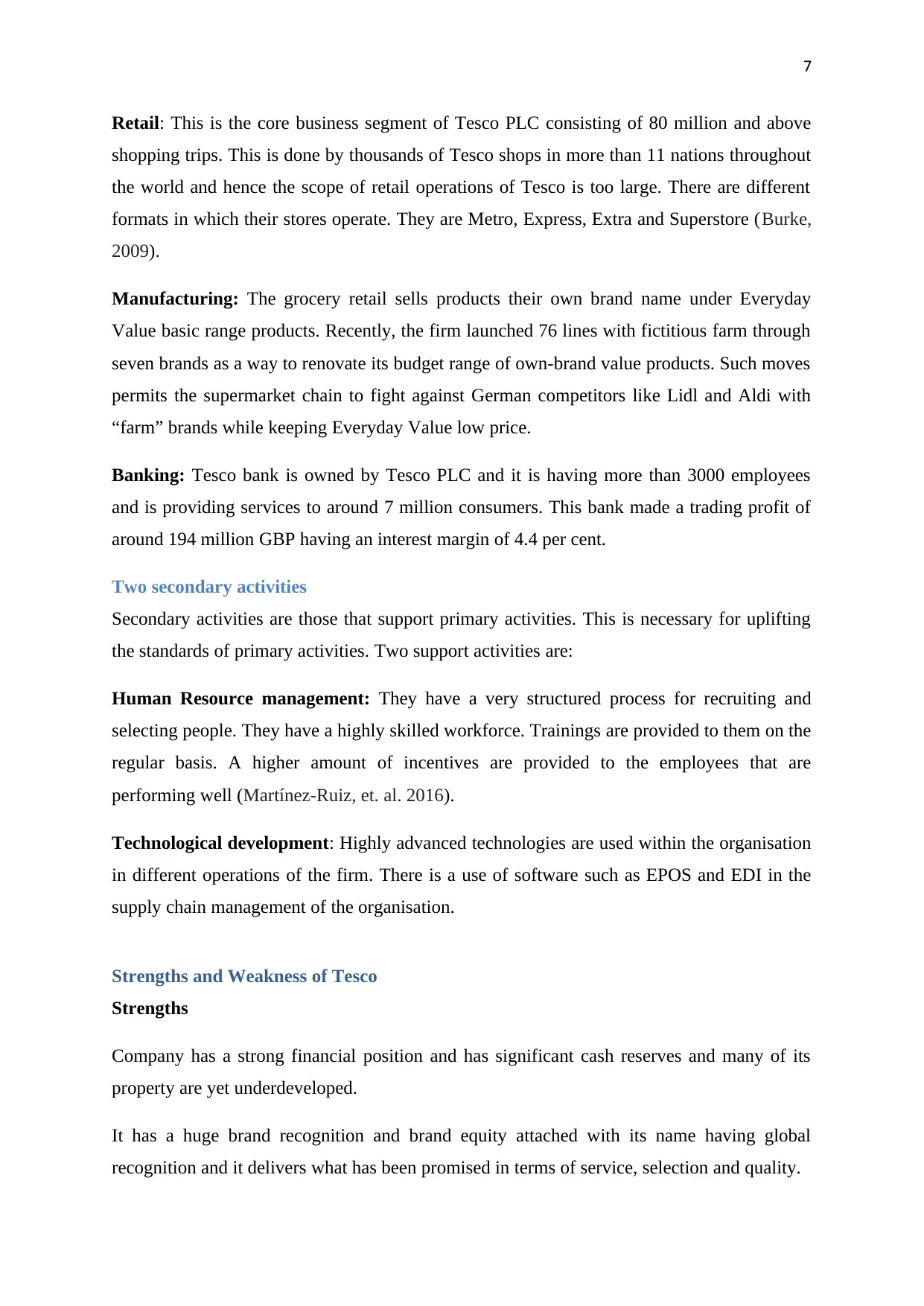
7
Retail: This is the core business segment of Tesco PLC consisting of 80 million and above
shopping trips. This is done by thousands of Tesco shops in more than 11 nations throughout
the world and hence the scope of retail operations of Tesco is too large. There are different
formats in which their stores operate. They are Metro, Express, Extra and Superstore (Burke,
2009).
Manufacturing: The grocery retail sells products their own brand name under Everyday
Value basic range products. Recently, the firm launched 76 lines with fictitious farm through
seven brands as a way to renovate its budget range of own-brand value products. Such moves
permits the supermarket chain to fight against German competitors like Lidl and Aldi with
“farm” brands while keeping Everyday Value low price.
Banking: Tesco bank is owned by Tesco PLC and it is having more than 3000 employees
and is providing services to around 7 million consumers. This bank made a trading profit of
around 194 million GBP having an interest margin of 4.4 per cent.
Two secondary activities
Secondary activities are those that support primary activities. This is necessary for uplifting
the standards of primary activities. Two support activities are:
Human Resource management: They have a very structured process for recruiting and
selecting people. They have a highly skilled workforce. Trainings are provided to them on the
regular basis. A higher amount of incentives are provided to the employees that are
performing well (Martínez-Ruiz, et. al. 2016).
Technological development: Highly advanced technologies are used within the organisation
in different operations of the firm. There is a use of software such as EPOS and EDI in the
supply chain management of the organisation.
Strengths and Weakness of Tesco
Strengths
Company has a strong financial position and has significant cash reserves and many of its
property are yet underdeveloped.
It has a huge brand recognition and brand equity attached with its name having global
recognition and it delivers what has been promised in terms of service, selection and quality.
Retail: This is the core business segment of Tesco PLC consisting of 80 million and above
shopping trips. This is done by thousands of Tesco shops in more than 11 nations throughout
the world and hence the scope of retail operations of Tesco is too large. There are different
formats in which their stores operate. They are Metro, Express, Extra and Superstore (Burke,
2009).
Manufacturing: The grocery retail sells products their own brand name under Everyday
Value basic range products. Recently, the firm launched 76 lines with fictitious farm through
seven brands as a way to renovate its budget range of own-brand value products. Such moves
permits the supermarket chain to fight against German competitors like Lidl and Aldi with
“farm” brands while keeping Everyday Value low price.
Banking: Tesco bank is owned by Tesco PLC and it is having more than 3000 employees
and is providing services to around 7 million consumers. This bank made a trading profit of
around 194 million GBP having an interest margin of 4.4 per cent.
Two secondary activities
Secondary activities are those that support primary activities. This is necessary for uplifting
the standards of primary activities. Two support activities are:
Human Resource management: They have a very structured process for recruiting and
selecting people. They have a highly skilled workforce. Trainings are provided to them on the
regular basis. A higher amount of incentives are provided to the employees that are
performing well (Martínez-Ruiz, et. al. 2016).
Technological development: Highly advanced technologies are used within the organisation
in different operations of the firm. There is a use of software such as EPOS and EDI in the
supply chain management of the organisation.
Strengths and Weakness of Tesco
Strengths
Company has a strong financial position and has significant cash reserves and many of its
property are yet underdeveloped.
It has a huge brand recognition and brand equity attached with its name having global
recognition and it delivers what has been promised in terms of service, selection and quality.
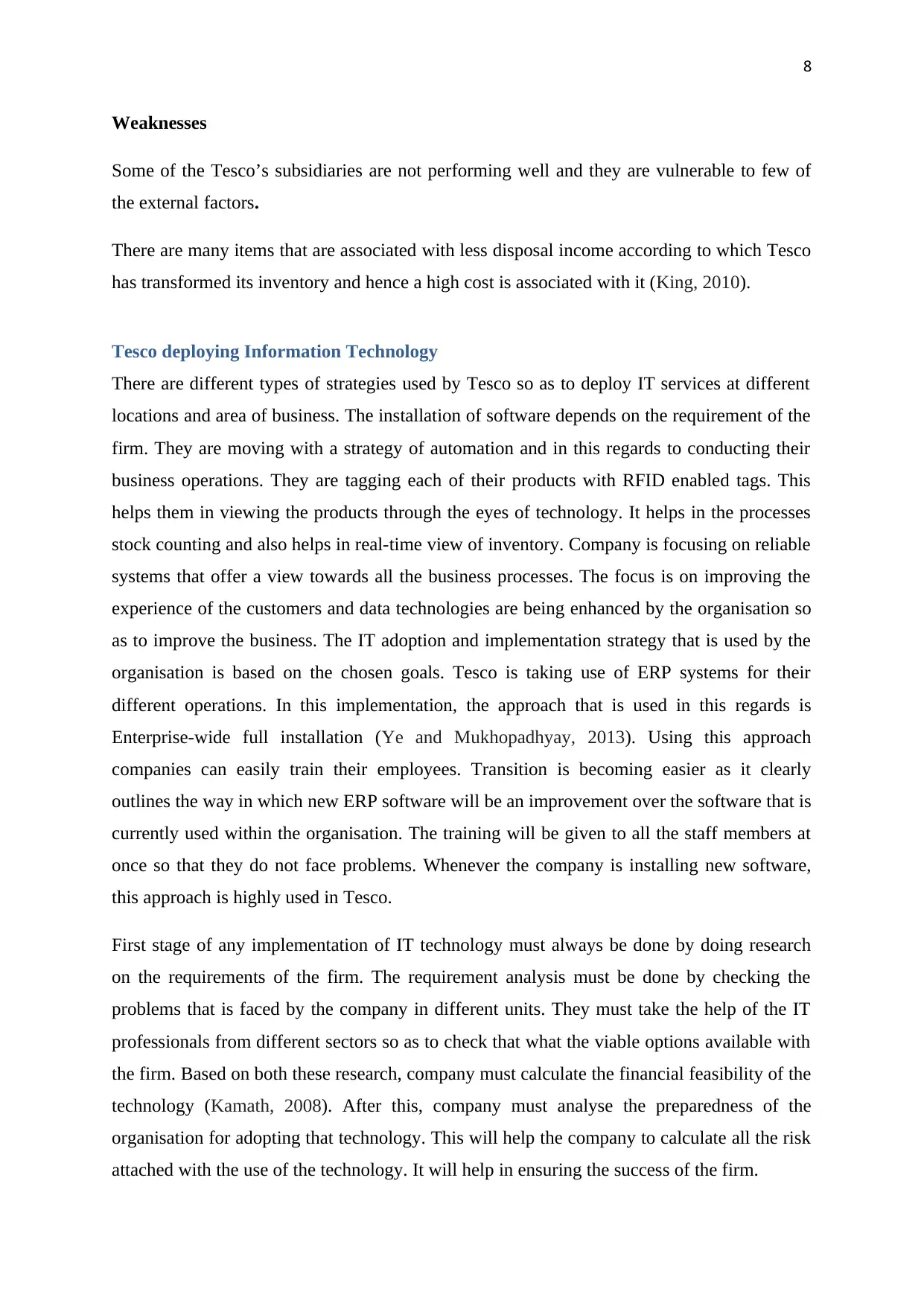
8
Weaknesses
Some of the Tesco’s subsidiaries are not performing well and they are vulnerable to few of
the external factors.
There are many items that are associated with less disposal income according to which Tesco
has transformed its inventory and hence a high cost is associated with it (King, 2010).
Tesco deploying Information Technology
There are different types of strategies used by Tesco so as to deploy IT services at different
locations and area of business. The installation of software depends on the requirement of the
firm. They are moving with a strategy of automation and in this regards to conducting their
business operations. They are tagging each of their products with RFID enabled tags. This
helps them in viewing the products through the eyes of technology. It helps in the processes
stock counting and also helps in real-time view of inventory. Company is focusing on reliable
systems that offer a view towards all the business processes. The focus is on improving the
experience of the customers and data technologies are being enhanced by the organisation so
as to improve the business. The IT adoption and implementation strategy that is used by the
organisation is based on the chosen goals. Tesco is taking use of ERP systems for their
different operations. In this implementation, the approach that is used in this regards is
Enterprise-wide full installation (Ye and Mukhopadhyay, 2013). Using this approach
companies can easily train their employees. Transition is becoming easier as it clearly
outlines the way in which new ERP software will be an improvement over the software that is
currently used within the organisation. The training will be given to all the staff members at
once so that they do not face problems. Whenever the company is installing new software,
this approach is highly used in Tesco.
First stage of any implementation of IT technology must always be done by doing research
on the requirements of the firm. The requirement analysis must be done by checking the
problems that is faced by the company in different units. They must take the help of the IT
professionals from different sectors so as to check that what the viable options available with
the firm. Based on both these research, company must calculate the financial feasibility of the
technology (Kamath, 2008). After this, company must analyse the preparedness of the
organisation for adopting that technology. This will help the company to calculate all the risk
attached with the use of the technology. It will help in ensuring the success of the firm.
Weaknesses
Some of the Tesco’s subsidiaries are not performing well and they are vulnerable to few of
the external factors.
There are many items that are associated with less disposal income according to which Tesco
has transformed its inventory and hence a high cost is associated with it (King, 2010).
Tesco deploying Information Technology
There are different types of strategies used by Tesco so as to deploy IT services at different
locations and area of business. The installation of software depends on the requirement of the
firm. They are moving with a strategy of automation and in this regards to conducting their
business operations. They are tagging each of their products with RFID enabled tags. This
helps them in viewing the products through the eyes of technology. It helps in the processes
stock counting and also helps in real-time view of inventory. Company is focusing on reliable
systems that offer a view towards all the business processes. The focus is on improving the
experience of the customers and data technologies are being enhanced by the organisation so
as to improve the business. The IT adoption and implementation strategy that is used by the
organisation is based on the chosen goals. Tesco is taking use of ERP systems for their
different operations. In this implementation, the approach that is used in this regards is
Enterprise-wide full installation (Ye and Mukhopadhyay, 2013). Using this approach
companies can easily train their employees. Transition is becoming easier as it clearly
outlines the way in which new ERP software will be an improvement over the software that is
currently used within the organisation. The training will be given to all the staff members at
once so that they do not face problems. Whenever the company is installing new software,
this approach is highly used in Tesco.
First stage of any implementation of IT technology must always be done by doing research
on the requirements of the firm. The requirement analysis must be done by checking the
problems that is faced by the company in different units. They must take the help of the IT
professionals from different sectors so as to check that what the viable options available with
the firm. Based on both these research, company must calculate the financial feasibility of the
technology (Kamath, 2008). After this, company must analyse the preparedness of the
organisation for adopting that technology. This will help the company to calculate all the risk
attached with the use of the technology. It will help in ensuring the success of the firm.
⊘ This is a preview!⊘
Do you want full access?
Subscribe today to unlock all pages.

Trusted by 1+ million students worldwide
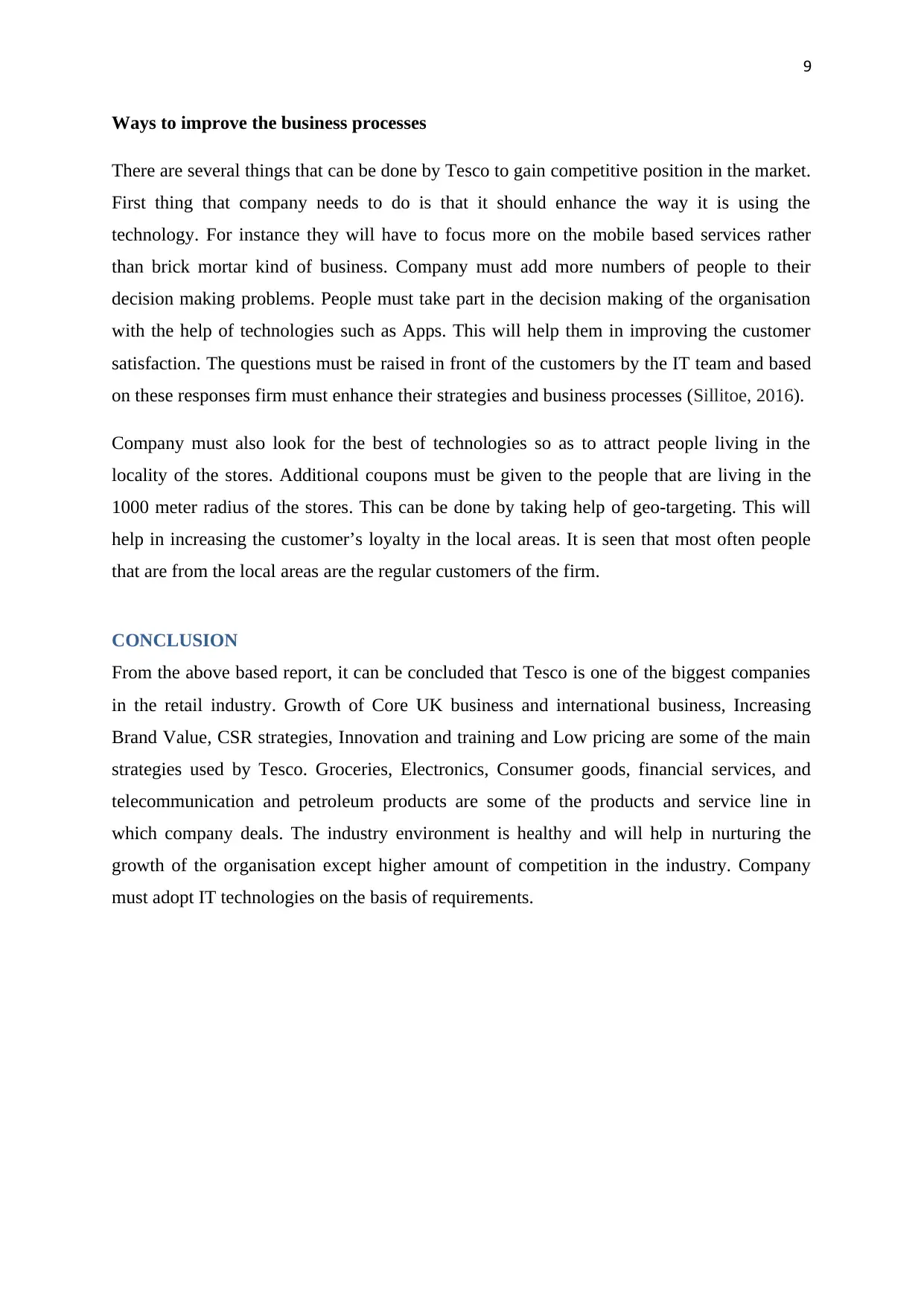
9
Ways to improve the business processes
There are several things that can be done by Tesco to gain competitive position in the market.
First thing that company needs to do is that it should enhance the way it is using the
technology. For instance they will have to focus more on the mobile based services rather
than brick mortar kind of business. Company must add more numbers of people to their
decision making problems. People must take part in the decision making of the organisation
with the help of technologies such as Apps. This will help them in improving the customer
satisfaction. The questions must be raised in front of the customers by the IT team and based
on these responses firm must enhance their strategies and business processes (Sillitoe, 2016).
Company must also look for the best of technologies so as to attract people living in the
locality of the stores. Additional coupons must be given to the people that are living in the
1000 meter radius of the stores. This can be done by taking help of geo-targeting. This will
help in increasing the customer’s loyalty in the local areas. It is seen that most often people
that are from the local areas are the regular customers of the firm.
CONCLUSION
From the above based report, it can be concluded that Tesco is one of the biggest companies
in the retail industry. Growth of Core UK business and international business, Increasing
Brand Value, CSR strategies, Innovation and training and Low pricing are some of the main
strategies used by Tesco. Groceries, Electronics, Consumer goods, financial services, and
telecommunication and petroleum products are some of the products and service line in
which company deals. The industry environment is healthy and will help in nurturing the
growth of the organisation except higher amount of competition in the industry. Company
must adopt IT technologies on the basis of requirements.
Ways to improve the business processes
There are several things that can be done by Tesco to gain competitive position in the market.
First thing that company needs to do is that it should enhance the way it is using the
technology. For instance they will have to focus more on the mobile based services rather
than brick mortar kind of business. Company must add more numbers of people to their
decision making problems. People must take part in the decision making of the organisation
with the help of technologies such as Apps. This will help them in improving the customer
satisfaction. The questions must be raised in front of the customers by the IT team and based
on these responses firm must enhance their strategies and business processes (Sillitoe, 2016).
Company must also look for the best of technologies so as to attract people living in the
locality of the stores. Additional coupons must be given to the people that are living in the
1000 meter radius of the stores. This can be done by taking help of geo-targeting. This will
help in increasing the customer’s loyalty in the local areas. It is seen that most often people
that are from the local areas are the regular customers of the firm.
CONCLUSION
From the above based report, it can be concluded that Tesco is one of the biggest companies
in the retail industry. Growth of Core UK business and international business, Increasing
Brand Value, CSR strategies, Innovation and training and Low pricing are some of the main
strategies used by Tesco. Groceries, Electronics, Consumer goods, financial services, and
telecommunication and petroleum products are some of the products and service line in
which company deals. The industry environment is healthy and will help in nurturing the
growth of the organisation except higher amount of competition in the industry. Company
must adopt IT technologies on the basis of requirements.
Paraphrase This Document
Need a fresh take? Get an instant paraphrase of this document with our AI Paraphraser
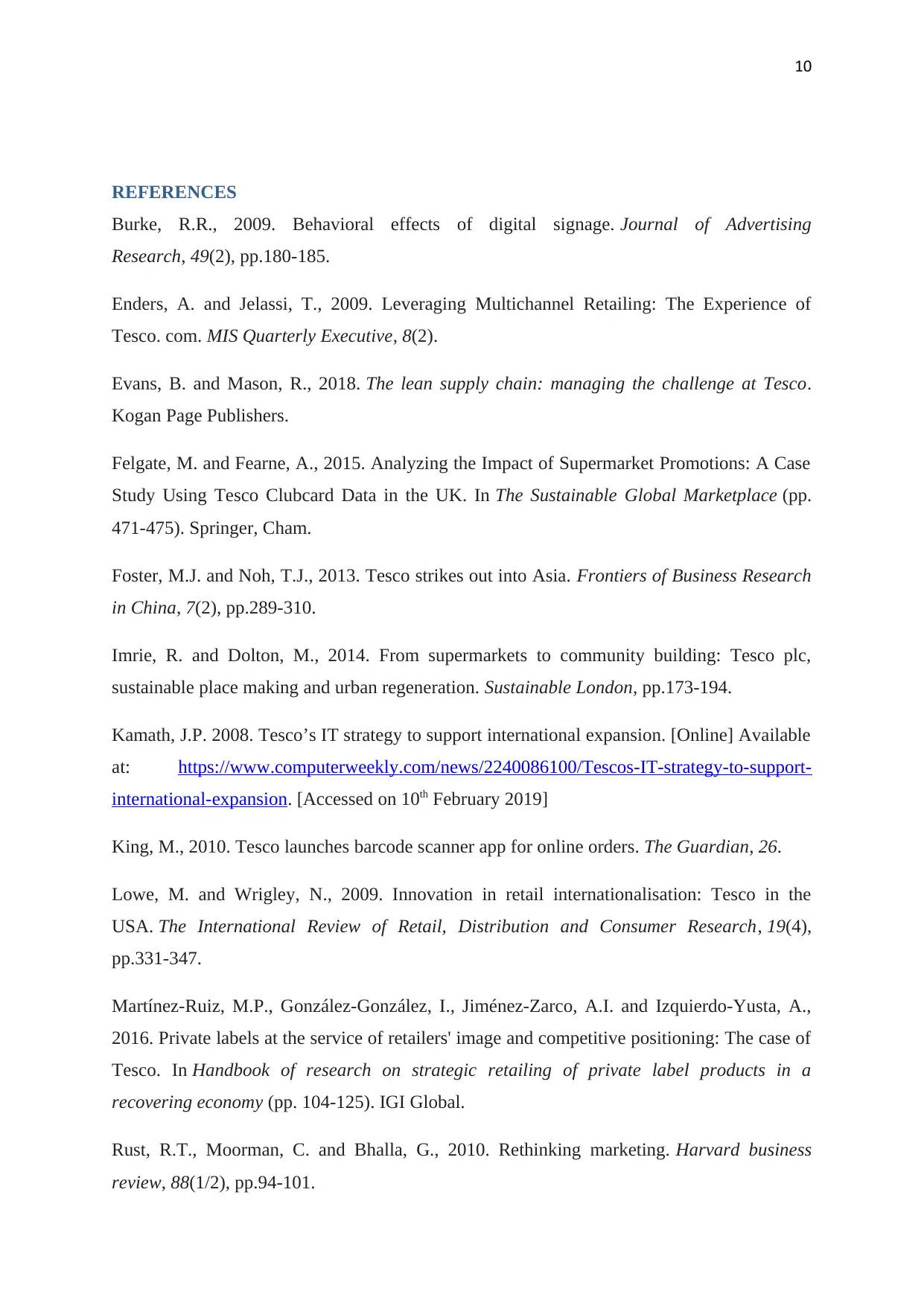
10
REFERENCES
Burke, R.R., 2009. Behavioral effects of digital signage. Journal of Advertising
Research, 49(2), pp.180-185.
Enders, A. and Jelassi, T., 2009. Leveraging Multichannel Retailing: The Experience of
Tesco. com. MIS Quarterly Executive, 8(2).
Evans, B. and Mason, R., 2018. The lean supply chain: managing the challenge at Tesco.
Kogan Page Publishers.
Felgate, M. and Fearne, A., 2015. Analyzing the Impact of Supermarket Promotions: A Case
Study Using Tesco Clubcard Data in the UK. In The Sustainable Global Marketplace (pp.
471-475). Springer, Cham.
Foster, M.J. and Noh, T.J., 2013. Tesco strikes out into Asia. Frontiers of Business Research
in China, 7(2), pp.289-310.
Imrie, R. and Dolton, M., 2014. From supermarkets to community building: Tesco plc,
sustainable place making and urban regeneration. Sustainable London, pp.173-194.
Kamath, J.P. 2008. Tesco’s IT strategy to support international expansion. [Online] Available
at: https://www.computerweekly.com/news/2240086100/Tescos-IT-strategy-to-support-
international-expansion. [Accessed on 10th February 2019]
King, M., 2010. Tesco launches barcode scanner app for online orders. The Guardian, 26.
Lowe, M. and Wrigley, N., 2009. Innovation in retail internationalisation: Tesco in the
USA. The International Review of Retail, Distribution and Consumer Research, 19(4),
pp.331-347.
Martínez-Ruiz, M.P., González-González, I., Jiménez-Zarco, A.I. and Izquierdo-Yusta, A.,
2016. Private labels at the service of retailers' image and competitive positioning: The case of
Tesco. In Handbook of research on strategic retailing of private label products in a
recovering economy (pp. 104-125). IGI Global.
Rust, R.T., Moorman, C. and Bhalla, G., 2010. Rethinking marketing. Harvard business
review, 88(1/2), pp.94-101.
REFERENCES
Burke, R.R., 2009. Behavioral effects of digital signage. Journal of Advertising
Research, 49(2), pp.180-185.
Enders, A. and Jelassi, T., 2009. Leveraging Multichannel Retailing: The Experience of
Tesco. com. MIS Quarterly Executive, 8(2).
Evans, B. and Mason, R., 2018. The lean supply chain: managing the challenge at Tesco.
Kogan Page Publishers.
Felgate, M. and Fearne, A., 2015. Analyzing the Impact of Supermarket Promotions: A Case
Study Using Tesco Clubcard Data in the UK. In The Sustainable Global Marketplace (pp.
471-475). Springer, Cham.
Foster, M.J. and Noh, T.J., 2013. Tesco strikes out into Asia. Frontiers of Business Research
in China, 7(2), pp.289-310.
Imrie, R. and Dolton, M., 2014. From supermarkets to community building: Tesco plc,
sustainable place making and urban regeneration. Sustainable London, pp.173-194.
Kamath, J.P. 2008. Tesco’s IT strategy to support international expansion. [Online] Available
at: https://www.computerweekly.com/news/2240086100/Tescos-IT-strategy-to-support-
international-expansion. [Accessed on 10th February 2019]
King, M., 2010. Tesco launches barcode scanner app for online orders. The Guardian, 26.
Lowe, M. and Wrigley, N., 2009. Innovation in retail internationalisation: Tesco in the
USA. The International Review of Retail, Distribution and Consumer Research, 19(4),
pp.331-347.
Martínez-Ruiz, M.P., González-González, I., Jiménez-Zarco, A.I. and Izquierdo-Yusta, A.,
2016. Private labels at the service of retailers' image and competitive positioning: The case of
Tesco. In Handbook of research on strategic retailing of private label products in a
recovering economy (pp. 104-125). IGI Global.
Rust, R.T., Moorman, C. and Bhalla, G., 2010. Rethinking marketing. Harvard business
review, 88(1/2), pp.94-101.
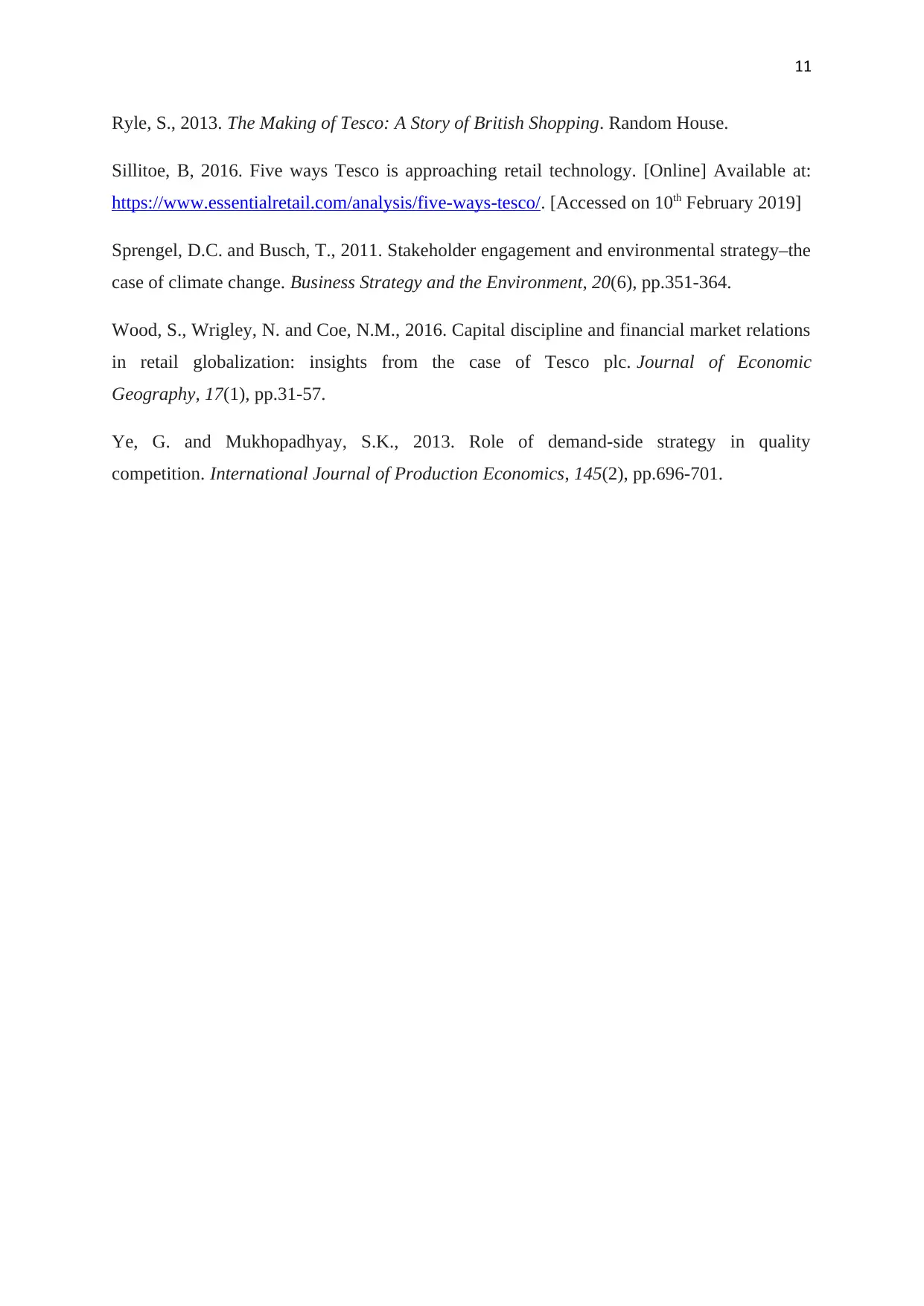
11
Ryle, S., 2013. The Making of Tesco: A Story of British Shopping. Random House.
Sillitoe, B, 2016. Five ways Tesco is approaching retail technology. [Online] Available at:
https://www.essentialretail.com/analysis/five-ways-tesco/. [Accessed on 10th February 2019]
Sprengel, D.C. and Busch, T., 2011. Stakeholder engagement and environmental strategy–the
case of climate change. Business Strategy and the Environment, 20(6), pp.351-364.
Wood, S., Wrigley, N. and Coe, N.M., 2016. Capital discipline and financial market relations
in retail globalization: insights from the case of Tesco plc. Journal of Economic
Geography, 17(1), pp.31-57.
Ye, G. and Mukhopadhyay, S.K., 2013. Role of demand-side strategy in quality
competition. International Journal of Production Economics, 145(2), pp.696-701.
Ryle, S., 2013. The Making of Tesco: A Story of British Shopping. Random House.
Sillitoe, B, 2016. Five ways Tesco is approaching retail technology. [Online] Available at:
https://www.essentialretail.com/analysis/five-ways-tesco/. [Accessed on 10th February 2019]
Sprengel, D.C. and Busch, T., 2011. Stakeholder engagement and environmental strategy–the
case of climate change. Business Strategy and the Environment, 20(6), pp.351-364.
Wood, S., Wrigley, N. and Coe, N.M., 2016. Capital discipline and financial market relations
in retail globalization: insights from the case of Tesco plc. Journal of Economic
Geography, 17(1), pp.31-57.
Ye, G. and Mukhopadhyay, S.K., 2013. Role of demand-side strategy in quality
competition. International Journal of Production Economics, 145(2), pp.696-701.
⊘ This is a preview!⊘
Do you want full access?
Subscribe today to unlock all pages.

Trusted by 1+ million students worldwide
1 out of 12
Related Documents
Your All-in-One AI-Powered Toolkit for Academic Success.
+13062052269
info@desklib.com
Available 24*7 on WhatsApp / Email
![[object Object]](/_next/static/media/star-bottom.7253800d.svg)
Unlock your academic potential
Copyright © 2020–2025 A2Z Services. All Rights Reserved. Developed and managed by ZUCOL.





